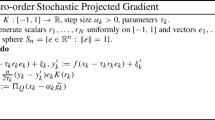Abstract
The online optimization model was first introduced in the research of machine learning problems (Zinkevich, Proceedings of ICML, 928–936, 2003). It is a powerful framework that combines the principles of optimization with the challenges of online decision-making. The present research mainly consider the case that the reveal objective functions are convex or submodular. In this paper, we focus on the online maximization problem under a special objective function \(\varPhi (x):[0,1]^n\rightarrow \mathbb {R}_{+}\) which satisfies the inequality \(\frac{1}{2}\langle u^{T}\nabla ^{2}\varPhi (x),u\rangle \le \sigma \cdot \frac{\Vert u\Vert _{1}}{\Vert x\Vert _{1}}\langle u,\nabla \varPhi (x)\rangle \) for any \(x,u\in [0,1]^n, x\ne 0\). This objective function is named as one sided \(\sigma \)-smooth (OSS) function. We achieve two conclusions here. Firstly, under the assumption that the gradient function of OSS function is L-smooth, we propose an \((1-\exp ((\theta -1)(\theta /(1+\theta ))^{2\sigma }))\)- approximation algorithm with \(O(\sqrt{T})\) regret upper bound, where T is the number of rounds in the online algorithm and \(\theta , \sigma \in \mathbb {R}_{+}\) are parameters. Secondly, if the gradient function of OSS function has no L-smoothness, we provide an \(\left( 1+((\theta +1)/\theta )^{4\sigma }\right) ^{-1}\)-approximation projected gradient algorithm, and prove that the regret upper bound of the algorithm is \(O(\sqrt{T})\). We think that this research can provide different ideas for online non-convex and non-submodular learning.


Similar content being viewed by others
Data Availability
Enquiries about data availability should be directed to the authors.
References
Abbassi Z, Mirrokni V, Thakur M (2013) Diversity maximization under matroid constraints. In: Proceedings of ACM SIGKDD, pp 32–40
Bian A, Levy K, Krause A, Buhmann, J (2017) Continuous dr-submodular maximization: structure and algorithms. In: Proceedings of NeurIPS, pp 486–496
Carbonell J, Goldstein J (1998) The use of mmr, diversity-based reranking for reordering documents and producing summaries. In: Proceedings of ACM SIGIR, pp 335–336
Chandra C, Quanrud K (2019) Submodular function maximization in parallel via the multilinear relaxation. In: Proceedings of SODA, pp 303–322
Chen L, Harshaw C, Hassani H, Karbasi A (2018a) Projection-free online optimization with stochastic gradient: From convexity to submodularity. In: Proceedings of ICML, pp 814–823
Chen L, Hassani H, Karbasi A (2018b) Online continuous submodular maximization. In: Proceedings of ICAIS, pp 1896–1905
Elad H (2016) Introduction to online convex optimization. Foundations and Trends® in Optimization 2:157–325
Garber D, Korcia G, Levy K (2020) Online convex optimization in the random order model. In: Proceedings of ICML, pp 3387-3396
Ghadiri M, Schmidt M (2019) Distributed maximization of submodular plus diversity functions for multilabel feature selection on huge datasets. In: Proceedings of AISTATS, pp 2077–2086
Hazan E, Agarwal A, Kale S (2007) Logarithmic regret algorithms for online convex optimization. Mach Learn 69:169–192
Kivinen J, Warmuth M (1999) Averaging expert predictions. In: Proceedings of EuroCOL, pp 153–167
Mehrdad G, Richard S, Bruce S (2021) Beyond submodular maximization via one sided \(\sigma \)-smoothness. In: Proceedings of SODA, pp 1006–1025
Nesterov Y (2003) Introductory lectures on convex optimization: a basic course. Springer Science and Business Media
Radlinski F, Dumais S (2006) Improving personalized web search using result diversification. In: Proceedings of ACM, SIGIR, pp 691–692
Streeter M, Golovin D (2020) An online algorithm for maximizing submodular functions. In: Proceedings of NeurIPS, pp 1577–1584
Thang N, Srivastav, A (2021) Online non-monotone dr-submodular maximization. In: Proceedings of AAAI, pp 9868–9876
Xin D, Cheng H, Yan X, Han J (2006) Extracting redundancy-aware top-\(k\) patterns. In: Proceedings of ACM SIGKDD, pp 444–453
Zadeh S, Ghadiri M, Mirrokni V, Zadimoghaddam M (2017) Scalable feature selection via distributed diversity maximization. In: Proceedings of AAAI, pp 2876–2883
Zhang H, Xu D, Gai L, Zhang Z (2022) Online one sided \(\sigma \)-smooth function maximization. In: Proceedings of COCOON 2022:177–185
Zinkevich M (2003) Online convex programming and generalized infinitesimal gradient ascent. In: Proceedings of ICML, pp 928–936
Acknowledgements
The first, second, and fourth authors are supported by National Natural Science Foundation of China (No. 12131003). The third author is supported by National Natural Science Foundation of China (No. 11201333).
Funding
This research was supported by NNSF of China (Grant Nos. 12131003 and 11201333).
Author information
Authors and Affiliations
Corresponding author
Ethics declarations
Conflict of interest
The authors have not disclosed any conflict of interest.
Additional information
Publisher's Note
Springer Nature remains neutral with regard to jurisdictional claims in published maps and institutional affiliations.
This is an extended version of a paper Zhang et al. (2022) presented in the the 26th International Computing and Combinatorics Conference.
Rights and permissions
Springer Nature or its licensor (e.g. a society or other partner) holds exclusive rights to this article under a publishing agreement with the author(s) or other rightsholder(s); author self-archiving of the accepted manuscript version of this article is solely governed by the terms of such publishing agreement and applicable law.
About this article
Cite this article
Zhang, H., Xu, D., Gai, L. et al. Online learning under one sided \(\sigma \)-smooth function. J Comb Optim 47, 76 (2024). https://doi.org/10.1007/s10878-024-01174-2
Accepted:
Published:
DOI: https://doi.org/10.1007/s10878-024-01174-2




